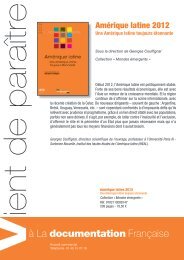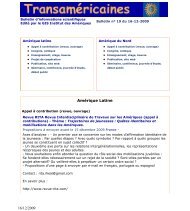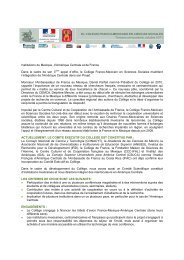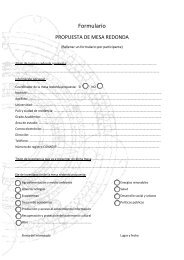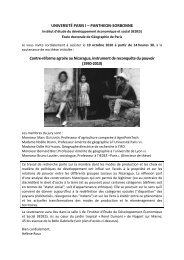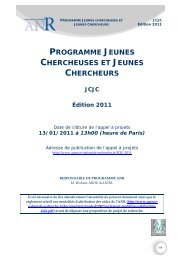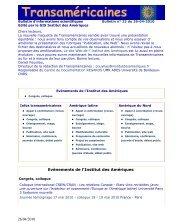Bulletin num. 33 du 25-03-2011 - Institut des Amériques
Bulletin num. 33 du 25-03-2011 - Institut des Amériques
Bulletin num. 33 du 25-03-2011 - Institut des Amériques
Create successful ePaper yourself
Turn your PDF publications into a flip-book with our unique Google optimized e-Paper software.
Transaméricaines91 sur 111 <strong>25</strong>/<strong>03</strong>/<strong>2011</strong> 10:44-- Part 3 : The Black Diaspora : Articulating Experiences and Theories-- 7. The Resource of the Ancestral Land : Pan-Africanism and Black Nationalism asProjects of a Durable Unity-- 8. Community Plurality or the A-Centred Community-- 9. Rastafari : An Allegorical Figure of the A-Centred Community-- Conclusion: Out of the Caribbean – For a Reformulated Model of the DiasporaRésumé d'éditeur :The forced migration of Africans to the Americas through the transatlantic slave tradecreated primary centres of settlement in the Caribbean, Brazil and the United States –the cornerstones of the New World and the black Americas. However, unlike Brazil andthe US, the Caribbean did not (and still does not) have the uniformity of a nationalframework. Instead, the region presents differing situations and social experiences bornof the varying colonial systems from which they were developed. Using the Caribbeanexperience as the focus, Christine Chivallon examines the transatlantic slave trade andslavery as founding events in the identification of a Black diaspora experience. Theexploration is extended to include the United States to exemplify contrasting situationsin slavery-based systems and identifies the links between the expressions of cultureemanating from the black populations of the New World and the diversity ofinterpretations of the cultural identities ! of the Black Americas.Divided into three main parts, The Black Diaspora of the Americas firstly examins thefoundation of the Black experiences of the New World by considering the slave trade.The second part takes a more theoretical examination of ‘Black diaspora’ usingRastafarianism, Garveyism and Pan-Africanism while referencing the work of a range ofthinkers including Stuart Hall, Paul Gilroy, Richard Price, Édouard Glissant, MelvilleHerskovits and Sidney Mintz. The work is concluded in the third part with the propositionof an a-centred community of persons of African <strong>des</strong>cent – a culture devoid of centrality.The Black Diaspora of the Americas brings together the key arguments about creolisationand the concept of a Black diaspora and presents an outstanding contribution tounderstanding the dynamics of diaspora.Mots-clés : Caraïbe ; esclavage ; traite ; diaspora noire ; panafricanisme ;rastafarianisme ; garveyismehttp://www.randlepublishing.com/Ouvrage - Saint-Jacques, Denis (Editeur scientifique) ; Robert, Lucie (Editricescientifique). La vie littéraire au Québec. Tome VI (1919-19<strong>33</strong>) Le nationaliste,l’indivi<strong>du</strong>aliste et le marchand. Sainte-Foy, Québec : Presses Universitaires de Laval,2010. 764 p.Canada Québec -Résumé d'éditeur :Durant l’entre-deux-guerres, les partisans <strong>du</strong> régionalisme paraissent dominer toutel’activité littéraire. Toutefois, la grande presse, les magazines, les romans en fasciculespuis, bientôt, la radio et le cinéma forment progressivement un marché culturel élargi,courtisant les jeunes et les ménagères, représentant le monde contemporain oupromettant l’aventure. Et c’est sans compter la poussée d’une jeune générationd’écrivains et d’écrivaines pressée d’en finir avec les vieilles querelles. Ils ont <strong>25</strong> ans en19<strong>25</strong>, n’attendent pas leur tour et investissent la poésie, le roman, la scène, leurinsufflant une bouffée d’air frais qui fait éclater les modèles traditionnels. L’espacelittéraire <strong>des</strong> années folles à la crise économique est ainsi ! marqué par l’affrontement deces trois forces. De L’appel de la race à La chair décevante, <strong>des</strong> Éditions Édouard Garandà la radio de CKAC, d’Aurore l’enfant martyre aux Fridolina<strong>des</strong>, les pratiques sediversifient et la littérature s’éloigne progressivement de la religion et de la politique. Dece bouillonnement émergent parfois <strong>des</strong> classiques, comme Un homme et son péché, quitraversent les barrières médiatiques et temporelles pour marquer de manière <strong>du</strong>rablel’imaginaire collectif.Mots-clés : Québec ; vie intellectuelle ; histoire littéraire ; influence étrangère ;transformation sociale ; acteur de la vie littéraire ; association littéraire ; théâtre ;



